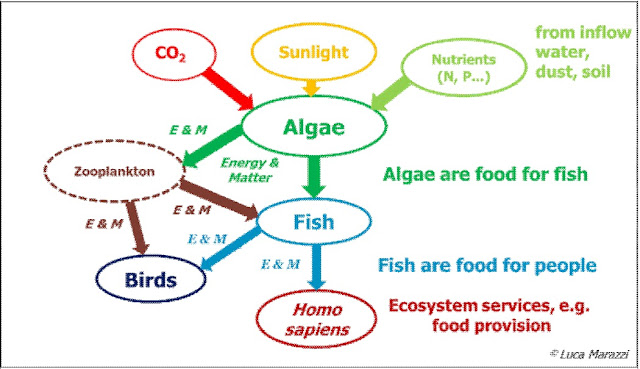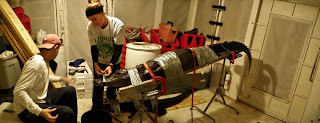Diatom of the Month: January 2017 – Amphora coffeaeformis
By Keely Mills*
I am a fan of hot temperatures and sunny climates. This may
sound strange coming from someone who lives in a wet and grey part of the UK (Nottingham). However, hot weather is
one of the main reasons I love researching tropical lakes, and a trait I share
with the January 2017 ‘Diatom of the Month’. I would like to introduce you to
my favourite diatom: Amphora
coffeaeformis (Fig. 1) [now renamed Halamphora
coffeaeformis]
– a salt-tolerant species, indicating a shallow, slightly saline environment
(Gasse, 1986).
Fig.
1. A
specimen of Amphora coffeaeformis found
in the sediments of Lake Nyamogusingiri, Uganda (photo: K. Mills).
So, how did I come to ‘discover’ this diatom, and how did
it come to be my favourite? My story starts as a new Ph.D. student at
Loughborough University in 2005. I was working with Dr David Ryves on a project focussed on the
Ugandan Crater Lakes, where I would use a palaeolimnological approach to infer past climate and
environmental changes that took place over the last 1,000 years or so (Mills, 2009; Mills & Ryves, 2012). Back in 2005 there was
much debate surrounding the spatial extent of wet and dry periods in East
Africa, and one of my aims was to feed in to this debate, assessing whether
past changes in rainfall in Uganda were similar (or different) to existing
records from large and small lakes in Kenya, Ethiopia, and Malawi.
Understanding the regional complexity of long-term changes in rainfall is
crucial for modelling the Earth’s climate system, and I hoped my research would
go some way to help.
Now, the region of western Uganda is as unique as it is
beautiful as it is home to more than 80 crater lakes, associated with the tectonic
activity related to the western arm of the East African Rift Valley System (Fig. 2).
Fig.
2. The four
crater lake clusters (FP=Fort Portal, Ka=Kasenda, KK=Katwe-Kikorongo,
Bu=Bunyaruguru) of western Uganda (as described by Melack, 1978), and images of
some of the crater lakes (clockwise from upper left): Kako, Kamunzuka,
Kifuruka, and Nyungu.
As part of my doctoral research, I obtained a sediment core
from Lake Nyamogusingiri (12.5 m deep, conductivity of 554 μS cm-1).
I analysed the diatom stratigraphy of this systems to allow me to infer changes
in lake level that might result from rainfall variations during key time
periods, such as the Little Ice Age (LIA) and the Mediaeval Climate Anomaly (MCA). In many lake sediment
records from East Africa, the impact of the LIA is quite chaotic, resulting in
dry periods interspersed with extremely wet periods (see CO2 Science for an overview). However,
the MCA was quite a dry period in this region. I hoped to identify these ‘wet’
and ‘dry’ periods using known ecological preferences of the different diatom
species, and a quantitative modelling approach.
After counting seemingly hundreds of samples from Lake
Nyamogusingiri, I was beginning to get a little disheartened. My sediment
samples were extremely diatom rich, but appeared to be full of Aulacoseira species (including the ‘Diatom of the Month – September 2016’)! Whilst their relative
abundances fluctuated, their presence (along with other species, such as Nitzschia
lancettula)
suggested that there was deep(ish) freshwater in this lake all the way back to
c. AD 1250…Devastated was not the word. Was I ever destined to find some
indication of regional drying in these lake systems? I pressed on, knowing I
had to finish counting the entire core.
But then Eureka! At
110 cm down. Around AD 1225. I spied my very first Amphora coffeaeformis (Table 1). I knew I had it in the bag - my
lakes were sensitive to the MCA (Fig. 3; Mills
et al., 2014).
Table 1: Amphora coffeaeformis – vital statistics (Gasse, 1986)
| |||
Authority
|
Agardh
| ||
Habitat
| |||
Water
|
Sodium-chloride; stagnant and running
| ||
Conductivity
|
1000 – >10,000 μS cm-1
| ||
pH
|
6 - <8.5
| ||
Alkalinity
|
2 - <50 meq. l-1
| ||
Temperature
|
10 - >35°C
| ||
Size#
|
Length: 15-40 μS
|
Width: 5-7 μS
|
Striae in 10 μm: 17-21 (centre)
|
Notes
|
Well developed in hot springs, or spring-fed rivers (Afar region).
Eurythermal, high temperatures (44°C) does not inhibit development
| ||
Fig.
3. Diatom
stratigraphy from Lake Nyamogusingiri showing selected taxa (> 8% in any one
sample), ordered by weighted-averaging optimum (ascending). The
appearance of Amphora coffeaeformis
is highlighted in the red box (from Mills et al., 2014).
Palaeolimnology, particularly the use of diatoms, is an
important tool in helping scientists to understand the response of lake systems
and their biota to past environmental perturbations (both natural and
human-induced). We can only understand the future impacts of a changing climate
and increased human pressures on freshwater resources by having some idea of
how these systems have responded in the past. Such data can allow us to implement
long-term management strategies of freshwater, especially in regions such as
East Africa that are water stressed, yet whose human populations rely heavily
on the ecosystem services that freshwater lakes provide.
References
Melack, J.M. (1978) Morphometric,
physical and chemical features of the volcanic crater lakes of western Uganda.
Archiv für Hydrobiologie 84: 430-453.
Gasse, F. (1986) East African diatoms:
Taxonomy, ecological distribution. Biblioteca Diatomologica 11, Crammer,
Berlin/Stuttgart, 201 pp.
Mills, K. (2009) Ugandan crater lakes:
limnology, paleolimnology and palaeoenvironmental history. PhD Thesis,
Loughborough University.
Mills, K., Ryves, D.B. (2012)
Diatom-based models for inferring past water chemistry in western Ugandan
crater lakes. Journal of Paleolimnology
48: 383-399.
Mills, K., Ryves, D.B., Anderson, N.J.,
Bryant, C.L., Tyler, J.J. (2014) Expressions of climate perturbations in western
Ugandan crater lake sediment records during the last 1000 years.




Comments
Post a Comment